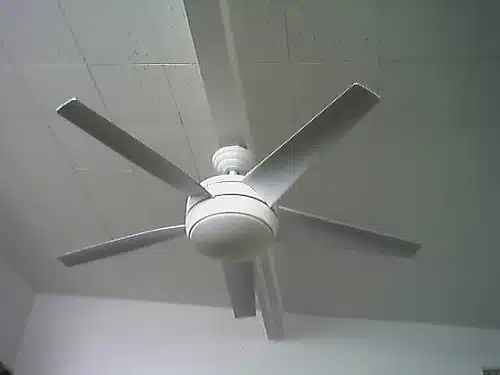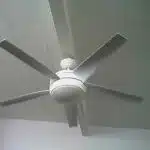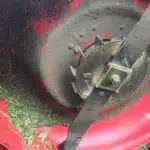Balancing a ceiling fan may seem like a daunting task, but with the right tools and techniques, it can be easily accomplished. A balanced ceiling fan not only improves its performance but also enhances the aesthetics of your home’s interior. As an expert in ceiling fan installation and balancing, I have seen how improper balance can lead to wobbling, noise and even damage to the fan itself.
In this article, I will provide you with step-by-step instructions on how to balance your ceiling fan using simple tools and techniques. You do not need to have any prior experience in electrical or mechanical work to balance your ceiling fan successfully. By following these instructions carefully, you will be able to achieve a perfectly balanced ceiling fan that runs smoothly and quietly. So let’s get started!
Signs That Your Ceiling Fan Needs Balancing
As a ceiling fan installation and balancing expert, it’s important to understand the common causes of unbalanced ceiling fans. One of the most common causes is an accumulation of dust and debris on the blades. This can cause the fan to wobble, leading to unnecessary wear and tear on the motor. DIY solutions include cleaning the blades regularly with a soft cloth or vacuum.
Another cause of unbalanced ceiling fans is bent or warped blades. This can happen over time due to exposure to extreme temperatures or humidity levels. If you notice any signs of warping, such as visible cracks or bends in the blades, it’s important to replace them as soon as possible. Otherwise, the unbalanced fan will continue to use more energy than necessary, leading to higher electricity bills.
Speaking of energy consumption, it’s also worth noting that unbalanced ceiling fans can have a significant impact on your home’s overall energy consumption. When a fan is off-balance, it requires more energy to spin at its normal speed. Over time, this can add up and lead to increased energy usage and higher utility bills. By regularly checking for signs of imbalance and taking steps to correct them, you can ensure that your ceiling fans are operating at peak efficiency while helping you save money in the process. With that said, understanding the importance of balanced ceiling fans is crucial for maintaining their health and longevity.
Understanding The Importance Of Balanced Ceiling Fans
As we have discussed in the previous section, it is important to recognize the signs that your ceiling fan needs balancing. This is because an imbalanced ceiling fan can cause a variety of problems, from excessive noise and wobbling to reduced efficiency and even damage to the motor or blades. However, simply recognizing that your fan needs balancing is not enough; it is equally important to understand why balanced fans are so crucial.
One of the most important reasons for regularly maintaining a balanced ceiling fan is safety. An imbalanced fan can become unstable and fall from the ceiling, potentially causing injury or damage. Additionally, an unbalanced fan can put undue stress on its components, leading to premature wear and tear. Over time, this can result in costly repairs or even replacement.
There are several common causes of ceiling fan imbalance. One of the most frequent culprits is a buildup of dust and debris on the blades and other components. This can cause uneven weight distribution and lead to wobbling or shaking during operation. Another common issue is loose or worn-out screws, which can also contribute to instability and imbalance. By staying vigilant about regular maintenance tasks like cleaning and tightening screws, you can help keep your ceiling fan running smoothly and safely for years to come.
Now that we have explored why balanced ceiling fans are so important and some common causes of imbalance, let’s move on to preparing the tools you need for balancing your ceiling fan properly.
Preparing The Tools You Need
Choosing the right balancing kit is essential for properly balancing a ceiling fan. There are various types of kits available in the market, such as blade balancing kits and clip-on weights. The blade balancing kit comes with adhesive weights that can be attached to the blades, while clip-on weights can be attached to the blades without any adhesive. It is important to choose a kit that is compatible with your ceiling fan model.
Steps for using a balancing kit efficiently involve first turning off the power to the fan and then cleaning it thoroughly. Next, attach the balancing clip or weight to one of the blades and turn on the fan to see if there is any improvement in its balance. If not, move on to another blade until you find the right one that needs adjustment. Once you have identified the unbalanced blade, adjust it by attaching or detaching weight until it reaches equilibrium.
Using a balancing kit efficiently requires patience and precision. Make sure to follow all instructions provided with your specific kit for best results. By selecting the appropriate kit and following proper techniques, you can ensure that your ceiling fan will operate smoothly and quietly. The next step in this process involves turning off power at the electrical box before starting any work on your ceiling fan’s motor or wiring system, which we will discuss in greater detail below.
Turning Off The Power To The Fan
After preparing the necessary tools, it’s time to turn off the power to the fan. Did you know that 15% of all electrical accidents in homes are caused by ceiling fans? Safety precautions are crucial, so make sure to switch off the appropriate circuit breaker or remove the fuse before proceeding.
Once you’ve turned off the power, it’s time to start balancing your ceiling fan. Here are three essential steps to guide you through this process:
- Check for loose screws and bolts: Before adjusting any blades, ensure that all the screws and bolts holding your fan together are tight. Loose parts can affect balance and cause unnecessary wobbling.
- Measure blade height: Using a ruler or measuring tape, measure the distance from each blade tip to your ceiling surface. The measurements should be within ⅛ of an inch of each other.
- Adjust blades as necessary: If there’s a significant difference in blade height, adjust each blade by bending it slightly upwards or downwards until they’re even.
Finally, when you’ve finished balancing your ceiling fan, it’s time to turn on the power again. Remember those safety precautions we talked about earlier? Make sure that everything is secured before turning on your circuit breaker or replacing your fuse.
Inspecting the blades for damage is a crucial step in ensuring that your ceiling fan runs smoothly and safely.
Inspecting The Blades For Damage
The first step in inspecting your ceiling fan blades for damage is to turn off the electricity supply. Never attempt to inspect or repair a fan while it is still connected to the power source. Once you have disconnected the power supply, carefully examine each blade for any signs of cracks or warping. These defects can cause uneven airflow and vibration, leading to poor performance and potential safety hazards.
Inspecting techniques involve checking for alignment issues, such as bent blades, which can affect the balance of your fan. If you notice any misalignment, you may be able to repair it by gently bending the blade back into place using a pair of pliers. Alternatively, you could replace the damaged blade entirely if it cannot be repaired. It’s essential to ensure that all blades are identical in size and shape; otherwise, this could also impact the balance of your fan.
If you identify any significant damage during your inspection, repairing options may include replacing individual blades or purchasing an entirely new fan if necessary. You should never attempt to use a damaged or unbalanced fan as this could cause it to wobble excessively and potentially fall from its mounting bracket. By regularly inspecting and maintaining your ceiling fan, you’ll ensure optimal performance and avoid costly repairs in the future.
Transition: Now that you’ve checked for any damages on your ceiling fan blades let’s look at how you can clean them effectively without damaging them further.
Cleaning The Blades
As a ceiling fan installation and balancing expert, it is essential to maintain your fan’s blades to ensure optimal performance. One aspect of maintenance that cannot be overlooked is cleaning the blades. Over time, dust and dirt can accumulate on the blades, causing them to become unbalanced and less efficient.
The frequency at which you should clean your ceiling fan blades depends on various factors such as usage, location, and environment. If you use your fan frequently or live in an area with high humidity or pollution levels, you may need to clean the blades more often. Generally, it is advisable to clean your ceiling fan blades every three months using appropriate cleaning methods.
When cleaning your ceiling fan blades, it is crucial to use gentle cleaning methods that do not damage the blades’ surface or finish. One effective way of cleaning the blades is by using a soft-bristled brush or microfiber cloth. Start by removing loose debris using a dry cloth before wiping down the blade’s surface with a damp cloth or sponge. Avoid using harsh chemicals or abrasive materials that could scratch or damage the blade surface.
Regularly maintaining and cleaning your ceiling fan blades can help prevent problems associated with an unbalanced fan such as wobbling or noisy operation. In addition, proper maintenance can extend your fan’s lifespan while ensuring optimal performance for years to come. In the next section, we will discuss how to balance your ceiling fan using a balancing kit.
Using A Balancing Kit
When installing and balancing a ceiling fan, counterweights must be identified and installed correctly to ensure the fan operates safely and efficiently. Counterweights should be chosen according to the weight of the fan, and should be adjusted by adding or removing weight to ensure balance. The counterweight kit should include instructions on how to properly install and adjust the counterweights. Regularly checking the fan for balance is important to ensure the fan operates safely and with minimal noise.
Identifying Counterweights
Ceiling fans are a great addition to any home, providing both style and comfort. However, if your ceiling fan is wobbling or making noise, it may be time to balance it. One way to do this is by using a balancing kit which includes counterweights that can help adjust the balance of the fan blades.
Identifying counterweights can be tricky as they often come in different shapes and sizes. Typically, they are small metal pieces that attach to the fan blades with screws or adhesive. These weights need to be placed strategically on the blades based on where the imbalance is occurring. To determine this, you can use a balancing kit to measure the amount of weight needed on each blade.
Once you have identified the counterweights needed for your ceiling fan, adjusting them is simple. Begin by turning off the fan and removing any dust or debris from the blades. Then, attach the weights in their designated location and test out the fan again. If it is still unbalanced, adjust the weights accordingly until you find the right combination for optimal performance. Remember that proper installation and maintenance of your ceiling fan not only improves its functionality but also extends its lifespan significantly.
Installing Counterweights
To achieve optimal performance and improve the lifespan of your ceiling fan, it is crucial to not only use a balancing kit but also install counterweights on the blades. Installing counterweights helps ensure that your fan operates smoothly and does not make any noise or wobble. When choosing the right balancing kit, make sure it includes counterweights in different sizes and shapes to cater to various types of ceiling fans.
To install counterweights, begin by turning off the fan and cleaning the blades thoroughly to remove any debris or dust. Once you have identified where the imbalance is occurring using a balancing kit, attach the counterweights strategically on each blade using screws or adhesive. It is important to place them correctly based on where the imbalance is occurring for optimal results.
After installing the counterweights, test out your ceiling fan again. If it still appears unbalanced or makes noise, adjust the weights accordingly until you find the right combination of weight distribution for optimal performance. Remember that proper installation and maintenance of your ceiling fan can significantly improve its functionality and extend its lifespan.
Starting With The First Blade
After obtaining a balancing kit, inspect each blade for any signs of damage or wear and tear. Ensure that the blades are securely attached to the fan’s motor assembly. Tighten any loose screws or bolts that may be present. Additionally, check the manufacturer’s manual for any specific instructions on how to balance your ceiling fan.
Weight adjustment techniques may vary between different balancing kits. Some kits may include adhesive weights which can be added to the blades to counterbalance any weight discrepancies. Alternatively, some kits may include clips that can be attached to the blades in order to adjust their weight distribution. Experiment with different weight placement options until you achieve a stable and balanced rotation.
Testing the balance of each blade is an important step in ensuring that your ceiling fan operates smoothly and efficiently. Turn on your ceiling fan at its highest speed setting and observe its rotation carefully. If you notice any wobbling or shaking, turn off the fan immediately and repeat the balancing process until you achieve a satisfactory result. A properly balanced ceiling fan will provide optimal air circulation without creating unnecessary noise or vibrations in your home.
Testing The Balance Of Each Blade
After mounting the ceiling fan, it’s essential to check whether each blade is balanced. A wobbling fan can create noise and decrease its efficiency. To test the balance, first, turn off the fan and let it come to a complete stop. Then, use a balancing kit or any other tool that can measure weight.
One way to test the balance is by using a blade-weighing kit. This kit comes with clips that you attach to each blade’s end and weights that you hang on them until they are levelled. The blade’s weight should be within 1/8 ounce of each other. Another effective method is by using a yardstick or any straight object placed along the leading edge of each blade. The distance from the ceiling to the yardstick should be equal for all blades.
It’s crucial to note that while testing the balance of each blade, you should also evaluate your chosen balance kit’s effectiveness. Some kits may not provide accurate results due to their design, so choose one that has been proven effective in balancing ceiling fans. Only after adequately testing and evaluating each blade’s balance should you proceed with adjusting their weights to achieve optimal performance.
Transition: Once you have determined which blades are out of balance and evaluated your choice of a balancing kit’s effectiveness, it’s time to adjust their weights for optimal performance.
Adjusting The Blade Weights
Once you have checked the blade alignment and found that it is not the cause of your ceiling fan wobbling, then adjusting the blade weights may be necessary. This process involves redistributing weight on each blade to ensure they all weigh the same. This will help keep your ceiling fan balanced and reduce any wobbling.
To adjust the blade weights, you will need to use a level to make sure each blade is pitched at the same angle. Adjusting blade pitch can be done by slightly bending each blade up or down until they are even. Once all blades are leveled, compare their weights using a balancing kit. The balancing kit usually comes with adhesive weights that can be attached to the lighter blades until they match the weight of the heaviest one.
Here are three steps to adjust your ceiling fan’s blade weights:
- Use a level to determine if there is any difference in pitch between each fan blade.
- Adjust each blade’s pitch by bending it slightly up or down until it matches the level of others.
- Use a balancing kit to add adhesive weights to lighter blades until all blades weigh equally.
Now that you have adjusted one blade’s weight, repeat this process for each of them. Make sure to double-check each time with a level before attaching weights as adjustments can sometimes affect subsequent measurements. By properly adjusting your ceiling fan’s blade weights, you can ensure its smooth operation and minimize any potential wobbling in the future.
Repeating The Process For Each Blade
After balancing the first blade, it is important to repeat the process for each of the remaining blades. This is necessary to ensure that each blade has the same weight distribution and that the fan operates smoothly. To do this, you will need to measure and adjust the weight of each blade individually.
To measure the weight of each blade, use a blade balancing kit or alternative tools such as a ruler or scale. Place each blade on a flat surface and measure its weight. Note down any discrepancies in weight between blades. If one blade is significantly lighter or heavier than the others, it may cause wobbling and affect the fan’s performance.
To adjust the weight of each blade, add or remove weights from their ends until they are all balanced. Blade weight can be adjusted by attaching adhesive weights to the back side of lighter blades or by drilling holes into heavier blades and filling them with material like epoxy or putty. Repeat this process until all blades have equal weight distribution.
Incorporating a table can help make this process easier for those who are balancing their ceiling fan for the first time. The table below shows an example of how to balance four-blade ceiling fans using different types of balancing kits:
| Balancing Kit Type | Number of Blades | Weight Adjustment |
|---|---|---|
| Adhesive Weights | 3 | Add up to 2 oz |
| Magnetic Clips | 2 | Add up to 1 oz |
| Screw-on Weights | 4 | Add up to 4 oz |
| Self-Adhesive Tape | 5 | Add up to 3 oz |
By following these steps and using appropriate tools, you can successfully balance your ceiling fan blades for optimal performance and eliminate any wobbling issues. Once you have completed this process, it is important to check your fan’s operation before completing installation.
Checking The Fan After Balancing
After repeating the process for each blade, it’s important to check the fan for accuracy. You can do this by turning on the fan and observing its movement. If you notice any wobbling or shaking, it means that the blades are not balanced properly and need to be rebalanced.
When rebalancing the fan, there are a few techniques you can use to ensure accuracy. One technique is to use a balancing kit that comes with weights that can be attached to the blades. Another technique is to add or remove weight from each blade until the fan runs smoothly. It’s important to keep adjusting and testing until you achieve perfect balance.
Testing accuracy and using appropriate rebalancing techniques are crucial steps in balancing a ceiling fan properly. Once you have achieved perfect balance, your ceiling fan should operate smoothly without any noise or wobbling. Now that your ceiling fan is balanced, it’s time to move on to other maintenance tasks such as lubricating the fan for optimal performance.
Lubricating The Fan
Applying lubricant to your ceiling fan is an important step in maintaining its efficiency and prolonging its lifespan. When it comes to choosing the right lubricant for your fan, there are various factors to consider. The type of lubricant you use depends on the material of the fan’s motor and bearings, as well as the climate conditions in which it operates.
For ceiling fans with oil ports, use a high-quality oil or grease recommended by the manufacturer. These lubricants are specifically designed for ceiling fans and ensure optimal performance. For sealed bearings, use silicone-based or synthetic oils that can withstand high temperatures without breaking down or losing their viscosity.
It is crucial to apply lubricant sparingly and avoid over-lubricating your fan. Over-lubrication can cause excess build-up, attracting dust and debris, which can damage your fan’s motor. A little goes a long way when it comes to applying lubricant to your ceiling fan – just a few drops should suffice. By following these tips, you can help ensure that your ceiling fan stays balanced and runs smoothly for years to come.
As important as it is to balance your ceiling fan correctly, regular maintenance is also key in extending its longevity. While proper lubrication helps keep things running smoothly, cleaning blades and tightening screws regularly will prevent any further imbalance from occurring. In our next section on maintaining a balanced ceiling fan, we’ll dive deeper into some specific tips for keeping your fan running as efficiently as possible.
Tips For Maintaining A Balanced Ceiling Fan
- Regular cleaning of a ceiling fan is essential to ensure the fan operates properly and efficiently.
- Wiping down the fan blades with a damp cloth on a regular basis will help reduce dust buildup and ensure the fan runs smoothly.
- Lubricating the fan’s motor is also important for proper fan maintenance. This will help reduce noise, improve air circulation, and ensure the fan runs quietly and efficiently.
- Ensuring that the fan blades are properly balanced is also vital for optimal performance. This can be done by adjusting the weight of the blades or by using a balancing kit.
Cleaning
Maintaining a clean and well-functioning ceiling fan is essential for homeowners who want to keep their homes cool during the warm months. Cleaning is one of the most important maintenance tips for any ceiling fan owner. A dirty fan can affect its balance, leading to wobbling and unnecessary noise. To avoid this, it’s crucial to clean the blades of your ceiling fan regularly.
To clean your ceiling fan, you’ll need a ladder or step stool, a microfiber cloth, and some cleaning solution. Start by turning off the power supply to the ceiling fan. Then climb up the ladder or step stool and use a microfiber cloth to wipe down each blade from top to bottom. If there are any stubborn stains on the blades, use a mild cleaning solution with warm water to gently scrub them away. Be sure not to get any liquid on the motor or electrical components.
By keeping your ceiling fan clean, you’re not only ensuring that it runs smoothly but also prolonging its lifespan. Regular cleaning will prevent dust build-up, which can damage the motor over time. It’s also important to note that fans in high-traffic areas may need more frequent cleaning than those in less-used rooms. By following these maintenance tips and keeping your ceiling fan in good condition, you’ll enjoy its cooling effects for years to come without worrying about any issues caused by poor maintenance practices.
Lubrication
Maintaining a balanced ceiling fan is crucial for optimal performance, and applying lubrication is an essential maintenance step. Lubrication helps reduce friction between the motor and other components, ensuring smooth operation and preventing premature wear and tear. There are different types of lubricants available for use on ceiling fans, including oil-based and silicone-based options.
Before applying any lubricant to your ceiling fan, it’s essential to turn off the power supply and let the blades come to a complete stop. Then, use a clean cloth to wipe away any dust or debris from the motor housing and other components. Next, apply a small amount of lubricant to each bearing or pivot point on the motor housing using a dropper or syringe. Be careful not to over-lubricate as this can attract more dirt and debris, leading to further issues down the line.
In summary, proper lubrication is crucial for maintaining a balanced ceiling fan that runs smoothly and efficiently. By choosing the right type of lubricant and applying it correctly, homeowners can prolong their fan’s lifespan while avoiding unnecessary repairs or replacements. Regular maintenance practices such as cleaning, balancing, and lubricating can help keep your ceiling fan in top shape for years to come.
Troubleshooting Common Ceiling Fan Issues
Ceiling fans are a great addition to any room, providing both style and function. However, like most appliances, they can experience problems that require troubleshooting. One common issue is wobbling or shaking, which can be caused by a variety of factors.
Common causes of ceiling fan wobbling include improper installation, unbalanced blades, loose screws or components, and bent blade brackets. DIY fixes for these issues include tightening all screws and bolts, adjusting the blade pitch angle to ensure balance, using a balancing kit to correct any imbalances in the blades themselves, and checking for any bent or damaged blade brackets that may need replacing.
When attempting DIY fixes for a wobbling ceiling fan, it’s important to take safety precautions such as turning off power at the circuit breaker and using caution when working with electrical components. If attempts at DIY repairs do not solve the problem or if there are other issues such as unusual noises or motor problems, it may be time to call in a professional. Cost estimates for professional ceiling fan repair vary depending on the specific issue and location but generally range from $50-$200.
Remember that regular maintenance can help prevent many common issues with ceiling fans. This includes cleaning blades regularly to prevent dust buildup and ensuring proper installation and balance during initial setup. By taking care of your ceiling fan properly and addressing any issues promptly, you can enjoy its cooling benefits for years to come without any frustrating problems.
Conclusion
Ceiling fans are a great way to keep your home cool and comfortable during hot weather. However, it’s important to make sure that your fan is balanced to avoid unnecessary noise and damage. If you notice any signs of wobbling or shaking, it may be time to balance your ceiling fan.
Balancing a ceiling fan is not as difficult as it may seem. With the right tools and techniques, you can ensure that your fan runs smoothly and efficiently. By following the steps outlined in this article, you can maintain a balanced ceiling fan for years to come.
As a professional in the ceiling fan installation and balancing industry, I encourage homeowners to take the time to inspect their fans regularly. A well-balanced ceiling fan not only keeps your home comfortable, but also saves energy and reduces noise pollution. So ask yourself: are you ready to take on the task of balancing your ceiling fan? With these helpful tips, you can easily achieve a perfectly balanced fan in no time!
Image Credits
- “Ceiling Fan” by jeffk (featured)





























